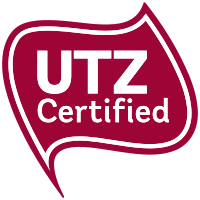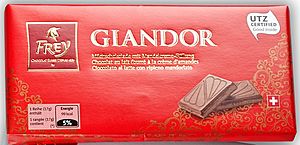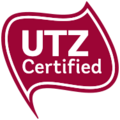UTZ Certified facts for kids
 |
|
| Non-profit organization | |
| Industry | Product certification, sustainability |
| Founded | Amsterdam, The Netherlands (2002) |
| Headquarters | Amsterdam, Netherlands |
|
Key people
|
Han de Groot, Executive Director |
|
Number of employees
|
400+ (2019) |
UTZ was a special program that helped farmers grow crops like coffee and cocoa in a way that was good for the planet and the people working on farms. It was also a label you might see on food packages.
This organization started in the Netherlands in 2002. The UTZ label appeared on over 10,000 products in more than 116 countries. By 2014, UTZ was known as the biggest program for growing coffee and cocoa in a sustainable way.
The UTZ program focused on how farms were run, the living conditions of workers, and protecting the environment. In January 2018, UTZ joined forces with another group called the Rainforest Alliance. They merged to better fight big problems like cutting down too many trees (deforestation), climate change, poverty, and unfairness in society.
Contents
- How UTZ Started and Grew
- Products That Were UTZ Certified
- UTZ Code of Conduct: Rules for Good Farming
- What Was the Impact of UTZ?
- How UTZ Products Were Priced
- See also
- Images for kids
How UTZ Started and Grew
UTZ began in 2002 with the name Utz Kapeh. This means 'Good Coffee' in the Quiché language, which is spoken by some Mayan people. It was started by a coffee farmer from Belgium and Guatemala, Nick Bocklandt, and a coffee seller from the Netherlands, Ward de Groote. Their main goal was to make farming sustainable on a large scale around the world.
Another group, the Solidaridad Network, also helped UTZ become a global standard. They provided money and helped put the ideas into practice on farms.
On March 7, 2007, the group officially changed its name and logo to UTZ Certified. Then, on January 1, 2016, they shortened the name again to just UTZ. The word 'UTZ' still means 'Good' in the Mayan language Quiché.
In June 2017, UTZ and the Rainforest Alliance announced they planned to merge. This merger was completed in January 2018. The combined organization is now known as the Rainforest Alliance.
Even though they merged, both organizations' old certification programs ran side-by-side for a while. However, since July 2021, a new certification program has been in place. This new program is based on the 2020 Sustainable Agriculture Standard. Farms that were certified under the old UTZ program can now get certified under this new program.
Products That Were UTZ Certified
UTZ helped make many different products more sustainable.
Sustainable Coffee Farming
UTZ was the second largest program in the world for sustainable coffee. In 2016, over 870,000 metric tons of coffee were UTZ certified. That's a lot of coffee!
Sustainable Cocoa Farming
The Cocoa Program started on October 10, 2007. UTZ worked with big companies like Ahold, Cargill, Heinz, Mars, and Nestlé to create a new system for sustainable cocoa. Other groups like Solidaridad and Oxfam Novib also supported this idea.
The first UTZ cocoa products appeared in stores in 2009. By 2014, UTZ became the biggest program for sustainable cocoa in the world. Over 336,300 cocoa farmers from 16 countries were part of the UTZ program. In 2017, UTZ was certifying about 1.5 million tons of cocoa. This was roughly two-thirds of all the certified cocoa in the world.
Sustainable Tea Farming
The UTZ program for tea and rooibos (a type of herbal tea) started in 2007.
Sustainable Hazelnut Farming
UTZ also started a program for hazelnuts in 2014. They wanted to see how they could make hazelnut farming more sustainable. This program first started in Turkey. Since then, it has grown and now includes countries like Georgia, Azerbaijan, Italy, and Spain.
UTZ Code of Conduct: Rules for Good Farming
The UTZ certification program was based on something called the UTZ Code of Conduct. This was a set of rules for farmers to follow. These rules covered how to grow crops responsibly and manage farms well.
Farmers who were UTZ certified had to follow this code. The 2014 version of the Code of Conduct was based on international rules for workers' rights. It also used the knowledge of many different people, including the farmers themselves. This made the code widely accepted.
There was a main set of rules that all farmers had to follow. Then, there were extra rules for specific products like coffee, cocoa, and tea. The system was designed for continuous improvement. This means farmers had to meet basic safety and quality rules from the start. Then, they added more rules to follow in the years that followed.
Main Categories of Rules
The rules in the UTZ Code of Conduct fell into four main groups:
How Farms Are Managed
- Finding ways to grow more crops.
- Having a system for groups of farms to manage themselves. This included doing yearly checks.
- Keeping good records.
- Checking for risks.
- Training workers and making them aware of the rules.
- Recording how much product was grown in the UTZ tracking system.
Farming Practices
- Choosing the right types of plants to grow.
- Taking care of the farm.
- Managing the health of the soil.
- Growing different types of crops to help nature and make the farm stronger financially.
- Controlling pests in a smart way.
- Using farm chemicals and fertilizers carefully and keeping records of their use.
- Watering crops properly.
- Handling products correctly during and after harvest.
Social and Living Conditions
- Following national laws and international rules about fair wages and working hours. This included the idea of a living wage for individual farms.
- No forced labor or child labour.
- Workers could join groups and bargain together.
- Making sure working conditions were safe and healthy. This included:
* Providing protective clothing for working with chemicals. * Giving safety training to workers in their own language.
- Treating everyone equally, no matter their gender.
- No unfair treatment (discrimination).
- Allowing people to express their culture freely.
- Making sure children could go to school.
- Providing good housing, clean drinking water, and health care for workers and their families.
Protecting the Environment
- Using water and energy wisely.
- Managing waste properly.
- Helping to increase the variety of plants and animals (ecological diversity).
- Protecting nature.
- Not cutting down primary forests (old, untouched forests).
- Respecting protected natural areas.
- Protecting animals and plants that are in danger.
- Reducing and preventing soil erosion (when soil is washed away).
- Taking steps to deal with climate change.
Special Rules for Different Products
Besides the main rules, there were specific rules for each type of product:
Coffee Rules
- Properly fermenting and handling coffee after it's picked.
- Treating wastewater from coffee processing.
Cocoa Rules
- Using shade trees to protect cocoa plants.
- Properly drying and fermenting cocoa beans.
Tea Rules
- Picking tea at the right time.
- Handling harvested tea leaves correctly.
- Checking the quality of the tea.
- Managing energy and wastewater.
Rooibos Rules
- Rotating crops (planting different things each year).
- Picking rooibos at the right time.
- Handling rooibos correctly after harvest.
- Preventing bush fires.
- Finding and protecting wild rooibos areas.
Tracking Products: Chain of Custody
To make sure that a product with an UTZ logo really came from an UTZ certified farm, the program had "chain of custody" rules. These rules helped track the product from the farm all the way to the store.
These rules included keeping UTZ certified products separate from regular products. They also required keeping records of who sold and bought the products.
How UTZ Products Were Traced
UTZ certified coffee, cocoa, and tea could be traced through the entire supply chain. UTZ used a special online system to do this.
When an UTZ certified farmer sold their products, they would record it in the UTZ online system. They would say what they were shipping, how much, and to whom. The buyer would then confirm this in the system. UTZ would give a special tracking number to this batch of products.
At the end of the supply chain, the company that made the final product (like a chocolate bar) used this tracking number. This helped them know their product truly came from a certified source. Some brands even used this tracking number to let customers trace their product back to the farm!
UTZ also helped manage the tracking system for another group called the Roundtable on Sustainable Palm Oil. This system started in December 2008.
Getting Certified
Independent groups, called third-party auditors, did yearly checks. They made sure that farmers followed the UTZ Code of Conduct.
Certification Bodies
A certification body (CB) is an independent group that checks farms. When UTZ Certified approved them, these groups would visit coffee, cocoa, and tea farms every year. They would check if the farms followed the UTZ Code of Conduct and the Chain of Custody rules.
Trained Experts
An UTZ-trained agronomist was an expert who helped farmers. They were specially trained to help farmers follow the UTZ Code of Conduct. These experts could give advice on how to put the rules into practice and how to manage farms more efficiently.
What Was the Impact of UTZ?
In 2014, UTZ released its first report on its impact. This report looked at 24 different studies and data collected by UTZ. It said that UTZ cocoa, coffee, and tea farms often produced more crops and better quality crops than regular farms. Also, farmers who were trained in the UTZ Code of Conduct learned new things and adopted sustainable farming methods.
How UTZ Products Were Priced
Coffee, cocoa, and tea with an UTZ certification had extra value. This meant buyers knew the product was made according to an international standard for responsible production. In other words, it followed the UTZ Code of Conduct.
The price for UTZ certified coffee was decided by the buyer and seller. UTZ did not get involved in price talks. Unlike fair trade, UTZ did not set a minimum price that farmers had to be paid. Instead, the UTZ program focused on good farming practices. The idea was that by improving how they farmed, farmers could grow more and better quality crops, which would help them earn more money.
See also
 In Spanish: Certificado UTZ para niños
In Spanish: Certificado UTZ para niños
- Fair trade
- Ethical consumerism
- Harkin–Engel Protocol
- International Federation of Organic Agriculture Movements
Images for kids



